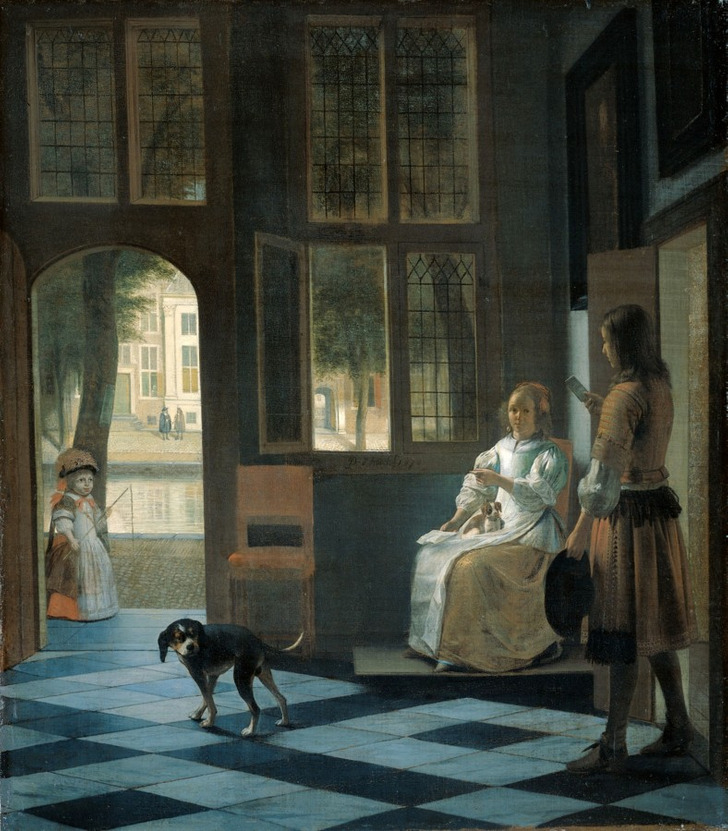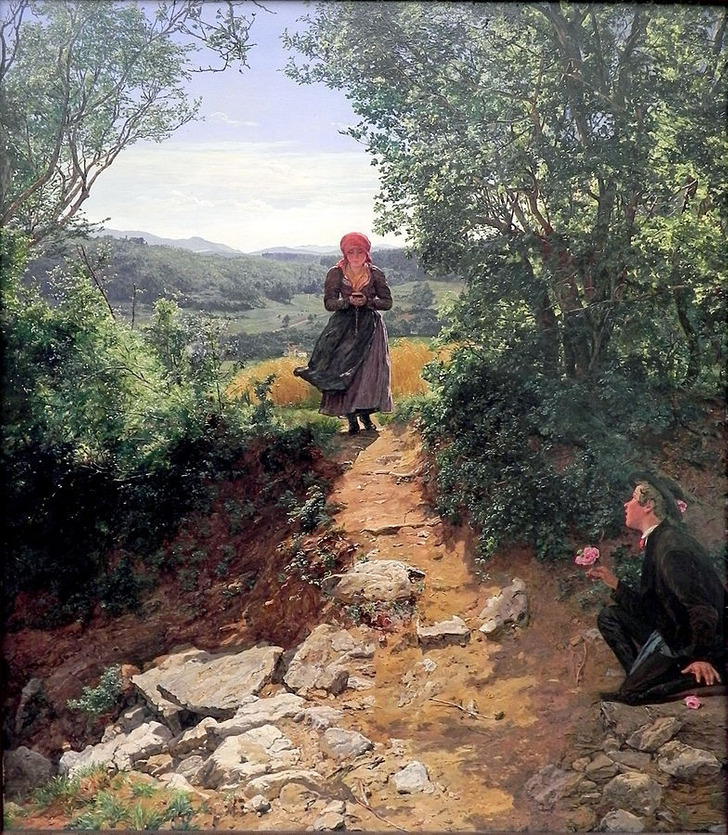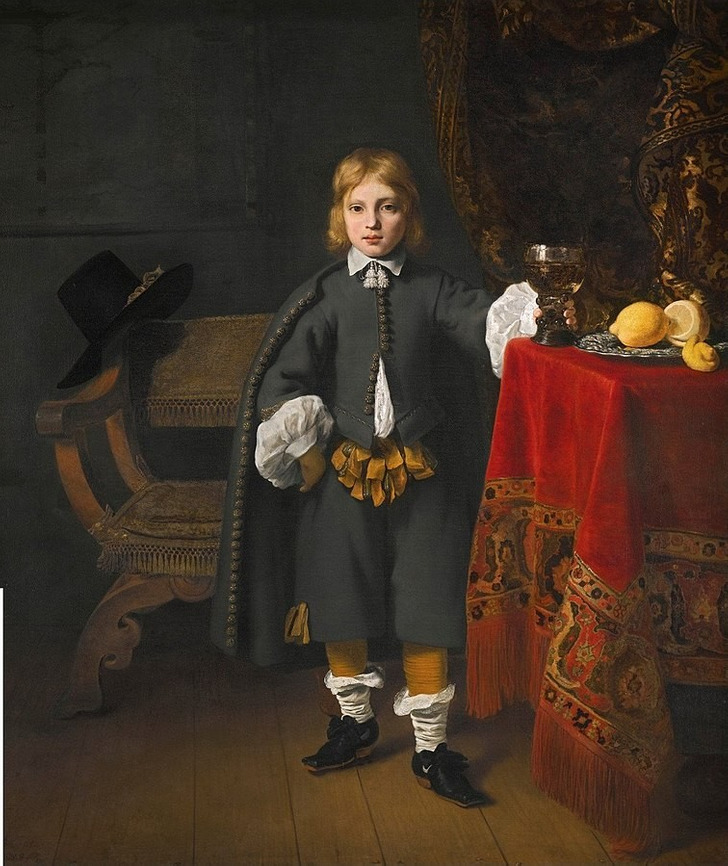How???
People Keep Finding iPhones in Ancient Paintings, and the Internet Is Baffled
The idea of time travel has long captivated human imagination, and recently, a peculiar theory has surfaced: the presence of iPhones in old paintings. In this article, we will explore four historical paintings that seemingly depict anachronistic iPhones and discuss the opinions of experts regarding this intriguing phenomenon.
Young Woman with a Letter and a Messenger in an Interior by Pieter de Hooch
A 350-year-old painting by Pieter de Hooch has sparked a wave of discussion about the possibility of time travel. The internet became captivated after Apple CEO Tim Cook mentioned in a press conference that he noticed a device resembling an iPhone in a piece of artwork during his visit to a museum in Amsterdam in 2016.
The painting, created in 1670, showcases a woman seated in a chair with a dog in her lap, while a man presents her with a “letter.” Amidst the artwork’s attention to detail, it was the letter itself that caught widespread attention following Mr. Cook’s statement. Although some art enthusiasts suggest that the man is simply handing over the rectangular-shaped letter to the woman, others believe it to be an intriguing Easter egg implying the existence of time travel.
Mr. Cook expressed his amazement and uncertainty about the invention of the iPhone. When questioned about the timeline and location of the iPhone’s creation, he replied, “I always thought I knew when the iPhone was invented, but now I’m not so sure anymore.” He proudly showed a photo to the audience, insisting, “It’s tough to see, but I swear it’s there.”
Waldmüller Die Erwartete by Ferdinand Georg Waldmüller
The captivating painting portrays a woman walking, seemingly oblivious to the world around her, while a man kneels in the foreground holding a flower. The stark contrast between her sunlit path and his shaded position captures attention. Originally gaining internet fame in 2017 when displayed at the Neue Pinakothek Museum in Munich, the image sparked humorous remarks suggesting she was ignoring the man due to being engrossed in swiping on Tinder.
However, the true meaning behind the painting reveals a different narrative. The woman’s intense focus is directed towards her hymn book, illustrating her deep devotion to God, surpassing earthly desires. This explanation, sourced from the gallery itself, may come as a surprise to those convinced that the image held evidence of time travel.
1937 (painting) by Ben Nicholson
The mural at the Springfield Main Post Office, painted in 1937, depicts the arrival of settlers to Springfield in the 1620s. However, there is a peculiar detail that catches the eye. Amongst the chaos of the scene, one of the Native Americans trading with William Pynchon appears to be staring at a modern object that closely resembles a smartphone.
The artist of the mural passed away in 1982, well before the invention of the iPhone. One possible explanation offered is that the object in question may be of European descent. “There’s reason to believe, then, that what the man is examining is not an indigenous object, but rather of European origin, like mirrors, which were presented often in such exchanges,” he shared.
“The way the man holds it up, if indeed he’s looking at his own face reflecting back at him, would certainly make sense,” he added.
The Betrothal of Robert Burns and Highland Mary engraving, 1886
The piece showcases the renowned Scottish poet Robert Burns holding a rectangular object, resembling an iPhone, as he declares his love for Mary Campbell. Created by artists R. Josey and James Archer, this engraving predates the invention of the iPhone by approximately 125 years.
However, there is a simpler explanation that dismisses the idea of time travel. The object that Burns is holding is more likely a religious book, as it aligns with the tradition of exchanging Bibles across a running stream during significant moments of love and commitment.
Bonus: Portrait of a Boy by Ferdinand Bol
The painting, titled Portrait of a Boy, was created in the 17th century by Dutch master Ferdinand Bol. It depicts an eight-year-old boy holding a goblet while resting his hand on his hip.
Upon closer inspection, observers noticed that the boy’s left shoe appears to have a white Nike “tick” logo, which is impossible considering Nike was founded in 1964, three centuries after the painting was created. This curious detail was first noticed by Fiona Foskett and her daughter, Holly, during their visit to the gallery.
“I said to my daughter, ’Hold on, is he wearing a pair of Nike trainers?’” Foskett shared. “Looking at the age, he must have got his hands on the first pair of Nike trainers ever made. Or is he actually a time traveler?”
As the mystery of iPhones appearing in ancient paintings continues to puzzle the online community, one can’t help but wonder: could this be evidence of time travel? Stay tuned for our next article, where we unravel a different kind of enigma. Join us as we explore eight compelling cases involving celebrities who seem to have defied the constraints of time, leaving behind a trail of evidence that suggests the existence of extraordinary temporal phenomena.
Comments
Related Reads
People Share 15 Tips That Sound Fake at First, but They Really Work

Your Life Before and After Marriage, in Pictures

A Young Woman Confessed Her Father Is Her Gynecologist, but What Drove People Crazy Is His Discovery

15+ Discovers That Blew Our Minds Away

Who the Most Beautiful Men in the World Are, According to Science

How These 12 Beauty Queens Who Made Charmed Millions Looked Then and Now

12+ Brilliant Ways People Caught Liars Red-Handed

12 Endearing Secrets People on Reddit Revealed to Be Keeping From Their Partners

My In-Laws Humiliated Me in Front of the Whole Family—I Refuse to Swallow That

12 Wild Stories That Prove Cheating Isn’t For the Faint-Hearted

16 Plot Twists That Are More Unexpected Than a Barking Cat

12 People Share Their Most Disturbing True Stories, and We’re Thankful They Didn’t Happen to Us




